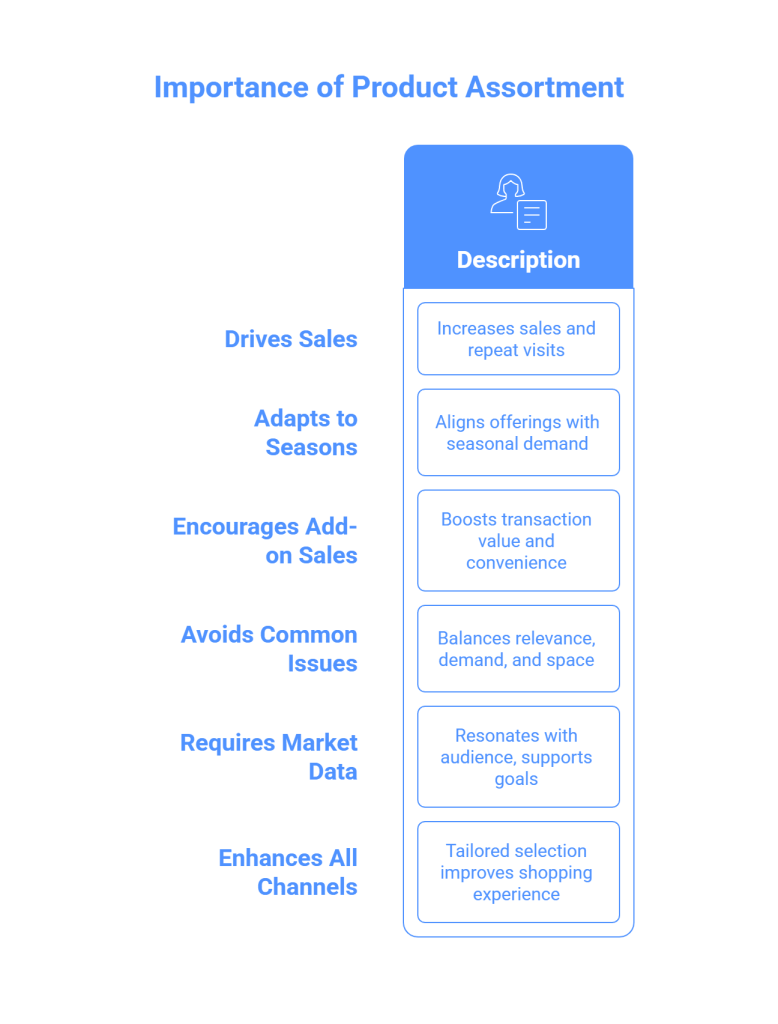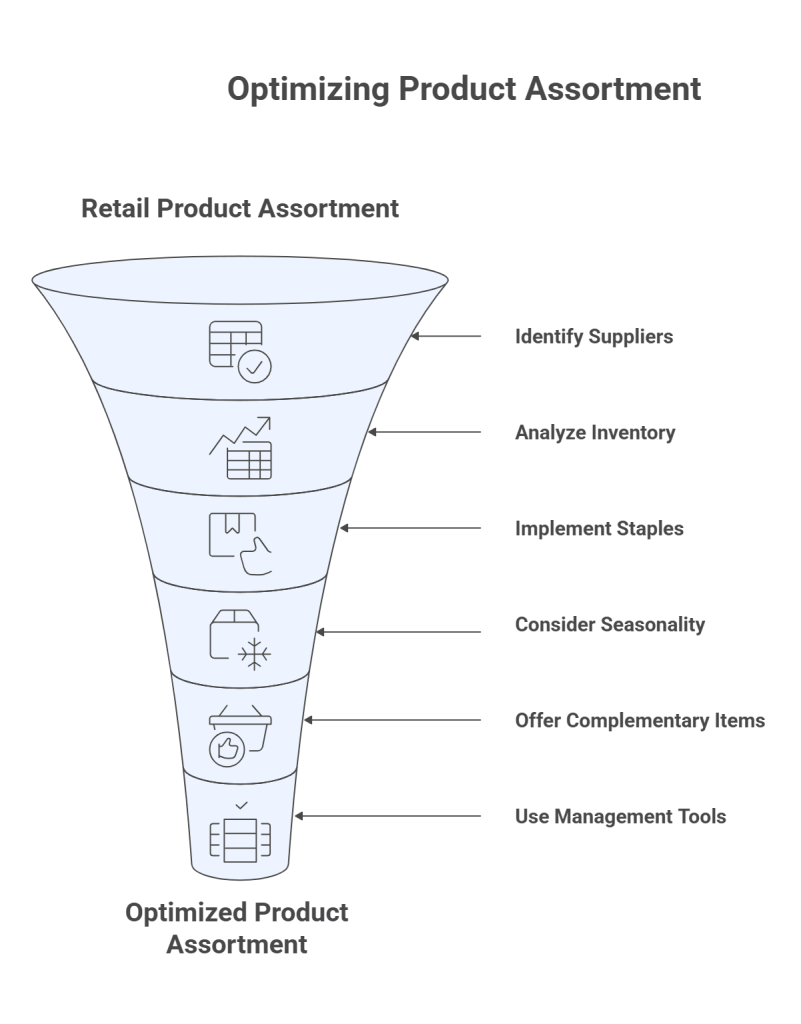
Crafting an effective product assortment strategy is imperative for retailers to establish a comprehensive, forward-thinking blueprint for their operations. However, this endeavor poses notable challenges.
Numerous pivotal tasks vie for a retailer’s attention, ranging from managing inventory levels and budgets to allocation, often relegating the variety and assortment of merchandise to a secondary priority. Yet, the assortment strategy defines a retailer’s identity. It must remain attuned to prevailing and forthcoming trends while accommodating the unique geo-demographics of its channels and locations.
Moreover, it should seamlessly integrate into the retail planning process to ensure alignment with financial and inventory objectives. How can retailers navigate this labyrinth of complexity?
That’s exactly what we’re dealing with today. In this blog, we will break down product assortment, dive into its meaning, plan around it, seek solutions and learn to optimize!
What is Product Assortment?
Product assortment encompasses the entire range of goods or services offered by a company, also known as the product mix or portfolio. It includes various product lines, which are related or similar products. Organizing products effectively is crucial for marketing and sales, facilitating easy navigation for consumers.
Importance of Product Assortment

Product assortment is a critical component of retail strategy that directly influences customer satisfaction, purchase behavior, and overall business performance. A well-planned assortment strategy ensures the right mix of products is available at the right time, in the right place, for the right customer.
1. Drives Sales and Customer Engagement
An effective assortment strategy shapes the selection of products customers interact with. By offering a well-curated range of items that appeal to customer preferences, retailers can significantly influence purchasing decisions and increase sales. A product assortment that meets diverse needs invites more engagement from shoppers and encourages repeat visits.
2. Adapts to Seasonal Changes
Successful retailers adjust their inventory based on changing seasons and trends:
- Example: Ice cream parlors may introduce tropical and fruity flavors in summer and spiced or warmer notes during monsoon or winter.
- Example: Fashion retailers expand their beachwear collection during summer or increase their winter clothing assortment as temperatures drop.
Aligning product offerings with seasonal demand enhances customer satisfaction and ensures relevance in every buying cycle.
3. Encourages Cross-Selling and Upselling
Strategic placement of complementary products encourages customers to buy more:
- Example: Supermarkets place toothbrushes next to toothpaste to prompt impulse or reminder purchases.
This tactic not only boosts the average transaction value but also creates a more convenient and satisfying shopping experience.
4. Avoids Assortment Pitfalls
An unbalanced or poorly thought-out product mix can have negative consequences:
- Overwhelming Variety: Too many choices can confuse customers and negatively impact their decision-making experience.
- Limited Selection: Offering too few options may lead to missed sales opportunities and dissatisfied customers.
Retailers must strike a balance by evaluating product relevance, customer demand, and available shelf or warehouse space.
5. Requires Data-Driven Insights
Before implementing an assortment strategy, it’s essential to perform in-depth market research. This includes analyzing:
- Target demographics
- Store or delivery location
- Local climate conditions
- Customer preferences and buying behavior
These insights help retailers develop a product mix that resonates with their audience and supports both revenue goals and customer satisfaction.
6. Enhances Omnichannel Experiences
Whether operating in a physical store or through an eCommerce platform, a tailored product assortment aligned with customer expectations enhances the overall shopping experience. Customizing the product selection per channel ensures both in-person and digital experiences are satisfying and productive.
Components of Product Assortment
Understanding the components of product assortment is vital for formulating effective retail strategies. Product assortment isn’t just about having more products—it’s about offering the right mix that aligns with customer needs and maximizes store efficiency. The two primary components of product assortment are product breadth and product variety.
1. Product Breadth
Product breadth refers to the range of different product categories a store offers. It is essentially the width of the retailer’s assortment.
- Example: A supermarket is a classic example of wide product breadth. In addition to food items, it may sell household products, cosmetics, medications, stationery, and more.
- The more categories a store offers, the broader its product breadth.
Retailers with wide product breadth cater to a larger audience by offering multiple types of products under one roof, which can increase convenience and encourage higher customer footfall.
2. Product Variety
Product variety (also referred to as product depth) denotes the number of different products or variations within a single category.
- Example: A specialty cereal store might focus only on breakfast cereals (narrow product breadth) but offer dozens of cereal types—such as organic, granola, protein-rich, gluten-free, and regional flavors—demonstrating deep product variety.
High product variety within a category allows retailers to meet diverse consumer preferences and cater to niche segments more effectively.
3. Balancing Breadth and Variety
Retailers develop their product assortment strategies based on an ideal blend of product breadth and variety, depending on factors like:
- Store size and layout
- Target customer base
- Brand identity and positioning
- Market demand and trends
Store Size and Constraints
Smaller retail outlets often face space limitations, forcing them to prioritize either breadth or variety. In contrast, a warehouse retailer (like Costco) typically adopts a broad assortment strategy by selling across multiple categories but offers limited choices within each—focusing more on essentials and bulk purchases. A niche retailer (like a cereal boutique store) may offer a narrow assortment (limited to one category) but ensure high variety within that particular category.
Product Assortment Strategies
1. Mass Market Assortment
It focuses on offering a wide range of products across multiple categories, appealing to diverse customer demographics. For instance, hypermarkets provide a plethora of items including food, clothing, electronics, kitchenware, and cleaning products.
2. Deep Assortment
This emphasizes a narrower selection of products but with extensive variety within each category. This approach, often seen in clothing stores, cultivates brand loyalty and enhances brand recognition through a rich array of styles and sizes.
3. Localized Assortment
It tailors product offerings to specific geographic locations, considering factors such as climate and fashion trends. This approach ensures relevance to local customers but may limit the potential customer base.
4. Wide Assortment
This is known to target broad demographics by offering a diverse range of product categories, albeit without extensive variety within each category. For example, general-purpose DIY and home improvement stores cater to various ages, socio-economic backgrounds, and locations.
5. Scrambled Assortment
Last but not least, this expands beyond a store’s primary focus by incorporating unrelated products to attract new customers. For instance, a gourmet market may diversify its offerings to include household supplies, local furniture, and gifts alongside its usual prepared foods and groceries.
Product Assortment Optimization

Achieving optimal product assortment is a primary goal for retailers, albeit a complex endeavor. Here are six recommended tips:
1. Identify the Right Suppliers
Selecting reliable suppliers is crucial for maintaining a consistent inventory supply. Dependable suppliers ensure timely delivery of high-quality goods, minimizing disruptions to business operations and preserving customer relations.
2. Execute Inventory Analysis
Analyze inventory to discern sales trends and identify product performance. Real-time reports from POS software facilitate informed decisions about product mix adjustments, such as expanding collections or diversifying variations based on customer demand.
3. Staples and Loss Leaders
Implementing a mix of staple products and loss leader strategies widens and deepens the product mix, attracting customers with essential items and encouraging additional purchases.
4. Consider Seasonality
Adjust product assortments according to seasonal demand to meet customer expectations and preferences. Tailoring assortments to specific seasons ensures relevance and maximizes sales potential.
5. Complementary Items
Offer complementary products that enhance the shopping experience and encourage additional purchases. Grouping products based on purpose rather than physical attributes can increase customer spending.
6. Use the Right Tools
Invest in reliable inventory management systems to streamline product assortment optimization processes. These tools aid in maintaining stock levels, tracking sales, and facilitating efficient decision-making.
Conclusion
Nailing down a solid plan for the products you sell is key to thriving. This plan, called a product assortment strategy, shapes how shoppers view your store and ultimately boosts sales.
Imagine it like solving a puzzle – you need to figure out what types of products to offer, how many options to provide, and where to focus your efforts. It’s a bit tricky, but with some careful thinking and the right tools, you can ace it.
That’s where Qodenext steps in. We’re pros at helping retailers manage their inventory and make smart decisions about which products to stock.
FAQs: Complete Guide to Product Assortment.
1. What is an example of product assortment?
A grocery store offering a wide range of categories—such as fresh produce, packaged snacks, beverages, household items, and toiletries—is a classic example of broad product assortment. This diversity caters to multiple customer needs under one roof.
2. What does the product assortment theory mean?
Product assortment theory refers to the strategic process of selecting, grouping, and presenting a range of products in a retail setting. It focuses on balancing consumer preferences, sales potential, inventory efficiency, and market trends to enhance the overall shopping experience and profitability.
3. Do I need professional help with product assortment?
Professional guidance can be highly beneficial, especially for businesses looking to optimize product selection, understand buyer behavior, or scale efficiently. Experts can leverage data analytics and market research to develop assortment strategies that reduce costs and improve inventory turnover.
4. What are the limitations of product assortment?
Some limitations include the risk of overwhelming customers with too many choices, difficulty tracking shifting consumer behaviors, and managing complex inventory levels. Additionally, frequent assortment adjustments may increase operational challenges and require investment in reliable planning tools.
5. How does product assortment impact customer satisfaction?
A thoughtfully curated product assortment helps retailers meet customer expectations by providing relevant and timely choices. When shoppers find exactly what they need—or even discover additional items—they’re more likely to have a positive experience, return to the store, and build loyalty.
6. What’s the difference between product breadth and product variety?
Product breadth refers to the number of different product categories offered, while product variety (or depth) refers to the number of options within each category. A store can have broad breadth with limited variety, or narrow breadth with deep variety, depending on its strategy.
7. How should small retailers approach product assortment?
Small retailers should focus on a niche strategy by offering a narrow category selection with a wide range of options that fit their brand identity and space constraints. Prioritizing customer preferences and rotating products seasonally can help maximize shelf space and customer satisfaction.
8. What factors influence product assortment planning?
Several factors influence planning, including target demographics, store size, location, climate, inventory budgets, seasonality, and consumer buying patterns. In-depth market research and data analytics play a key role in aligning assortment with business objectives.
9. How does localization influence assortment strategy?
Localized assortment focuses on tailoring product offerings to suit the tastes, needs, and climate of a specific geographic area. It helps retailers remain relevant in regional markets by stocking items that resonate with the local customer base, thereby increasing sales and satisfaction.
10. Can assortment strategy improve online and offline experiences equally?
Yes, a well-planned assortment strategy helps create seamless experiences across both channels. For physical stores, it ensures relevant, in-demand products are always available. For online platforms, assortment can be expanded through drop shipping or third-party fulfillment while maintaining product appeal.







